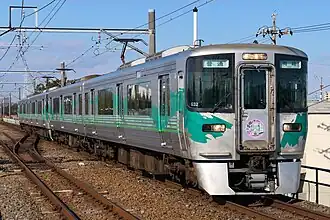Aichi Loop Railway 2000 series
| Aichi Loop Railway 2000 series | |
|---|---|
 Set G32 in original livery, December 2023 | |
| In service | March 2003 – present |
| Manufacturer | Nippon Sharyo |
| Constructed | 2002–2009 |
| Entered service | 14 March 2003 |
| Number built | 40 vehicles (20 sets) |
| Number in service | 40 vehicles (20 sets) |
| Formation | 2 cars per trainset |
| Fleet numbers | G1–G14, G31–G33, G51–G52 |
| Operators | Aichi Loop Railway |
| Depots | Kitano-Masuzuka |
| Lines served | Aichi Loop Line |
| Specifications | |
| Car body construction | Stainless steel |
| Car length | 20,100 mm (65 ft 11 in) |
| Width | 2,978 mm (9 ft 9 in) |
| Height | 4,020 mm (13 ft 2 in) |
| Doors | 3 pairs per side |
| Maximum speed | 110 km/h (68 mph) |
| Acceleration | 2.6 km/(h⋅s) (1.6 mph/s) |
| Electric system(s) | 1,500 V DC (overhead wire) |
| Current collection | Pantograph |
| Bogies | ND731 (motored) ND731T (trailer) |
| Track gauge | 1,067 mm (3 ft 6 in) |
The Aichi Loop Railway 2000 series (愛知環状鉄道2000系) is a 2-car electric multiple unit (EMU) train type operated by the Japanese third sector railway operator Aichi Loop Railway on the Aichi Loop Line since March 2003.[1]
It is based on the JR Central 313 series.[2]
Formations

As of 1 April 2012, the fleet consists of 20 two-car sets formed as shown below, with one motored (Mc) car and one trailer (Tc) car.[3]
| Designation | Tc | Mc |
|---|---|---|
| Numbering | 2200 | 2100 |
| Weight (t) | 37.1 | 31.2 |
| Capacity (total/seated) | 146/56 | 140/51 |
- Sets G31-G33 have cars numbered in the 213x and 223x series.
- Sets G51-G52 have cars numbered in the 215x and 225x series.
- The Mc cars are equipped with one single-arm pantograph (sets G8-G11 have two pantographs).[3]
Interior
Passenger accommodation consists of fixed facing 4-seat bays with bench seating by the doorways.[1] Sets G51 and G52 have longitudinal seating throughout.[3] The Tc cars have a universal access toilet.[1] The G30 sets were originally configured to allow tables to be installed, and included internal speakers for use with karaoke equipment on special event services,[1] but these features were subsequently removed.[3]
-
 Interior
Interior -
 Toilet (at left)
Toilet (at left) -
 Driver's cab
Driver's cab
History
The first four sets, G1-G2 and G31-G32, were delivered to allow driver training between January and March 2003.[1]
From December 2009, the original sets were gradually repainted into the corporate livery with blue bodyside stripes, and the seat moquette was also changed from green to blue.[4]
References
- ^ a b c d e 愛知環状鉄道2000系 [Aichi Loop Railway 2000 series]. Japan Railfan Magazine (in Japanese). Vol. 43, no. 503. Japan: Koyusha Co., Ltd. March 2003. pp. 78–79.
- ^ 愛知環状鉄道2000系の表示器がLED式に交換される [Aichi Loop Railway 2000 series to be retrofitted with LED information displays]. Japan Railfan Magazine Online (in Japanese). Japan: Koyusha Co., Ltd. 5 May 2025. Retrieved 7 May 2025.
- ^ a b c d 私鉄車両編成表 2012 [Private Railway Rolling Stock Formations – 2012]. Japan: JRR. July 2012. p. 97. ISBN 978-4-330-29911-2.
- ^ 車両デザインの変更について [Details of train design changes]. News release (in Japanese). Japan: Aichi Loop Line Co., Ltd. 2009. Retrieved 26 March 2013.
External links
- Aichi Loop Railway 2000 series (Nippon Sharyo) (in Japanese)
- Aichi Loop Railway 2000 series (Japan Railfan Magazine Online) (in Japanese)
- Aichi Loop Railway 2000 series 6th-batch type (Japan Railfan Magazine Online) (in Japanese)